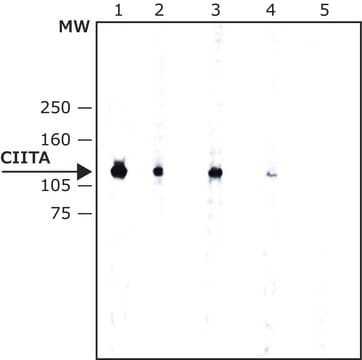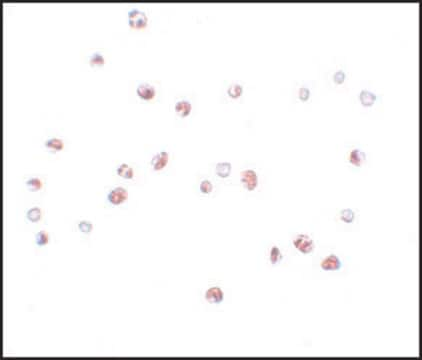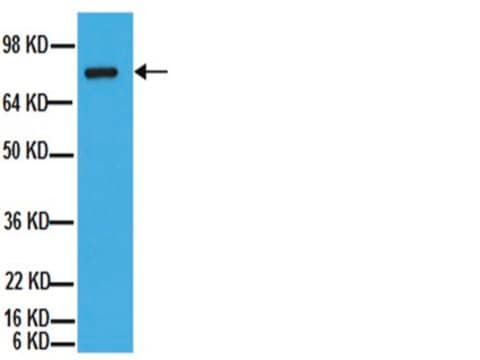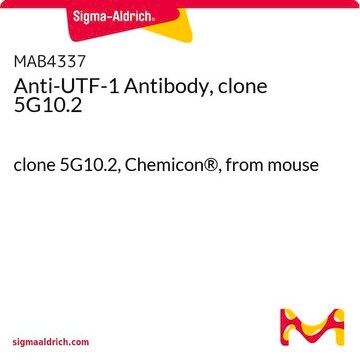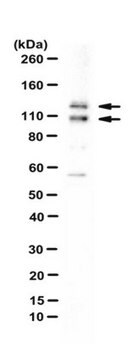MABF260
Anti-NLRC5 Antibody, clone 3H8
clone 3H8, from rat, purified by using protein G
Synonim(y):
Protein NLRC5, Caterpiller protein 16.1, CLR16.1, Nucleotide-binding oligomerization domain protein 27, Nucleotide-binding oligomerization domain protein 4
About This Item
Polecane produkty
pochodzenie biologiczne
rat
Poziom jakości
forma przeciwciała
purified antibody
rodzaj przeciwciała
primary antibodies
klon
3H8, monoclonal
oczyszczone przez
using protein G
reaktywność gatunkowa
human
metody
flow cytometry: suitable
immunoprecipitation (IP): suitable
western blot: suitable
izotyp
IgG1, kappa
numer dostępu UniProt
Warunki transportu
wet ice
docelowa modyfikacja potranslacyjna
unmodified
informacje o genach
human ... NLRC5(84166)
Powiązane kategorie
Opis ogólny
Specyficzność
Immunogen
Zastosowanie
Immunoprecipitation Analysis: A representative lot detected poly(I:C) (Cat. No. 528906) treatment-induced upregulation of endogenous NLRC5 in HeLa cells by IP-Western blotting analysis of both cytosolic and nuclear fractions. A strong NLRC5 nuclear accumulation was seen upon nuclear export inhibition by LepB (Cat. No. 431050) treatment, whereas NLRC5 was mainly cytoplasmic in untreated cells (Neerincx, A., et al. (2012). J. Immunol. 188(10):4940-4950).
Western Blotting Analysis: A representative lot detected NLRC5 in THP-1 cell lysate as well as exogenously expressed FLAG-tagged NLRC5 in lysate from transfected HEK293T cells. Target band detection was greatly diminished using lysates from NLRC5 siRNA-transfected THP-1 cells. (Neerincx, A., et al. (2010). J. Biol. Chem. 285(34):26223-26232).
Inflammation & Immunology
Immunoglobulins & Immunology
Jakość
Western Blotting Analysis: 1 µg/mL of this antibody detected NLRC5 in 10 µg of Raji cell lysate.
Opis wartości docelowych
Postać fizyczna
Przechowywanie i stabilność
Inne uwagi
Oświadczenie o zrzeczeniu się odpowiedzialności
Not finding the right product?
Try our Narzędzie selektora produktów.
Kod klasy składowania
12 - Non Combustible Liquids
Klasa zagrożenia wodnego (WGK)
WGK 1
Temperatura zapłonu (°F)
Not applicable
Temperatura zapłonu (°C)
Not applicable
Certyfikaty analizy (CoA)
Poszukaj Certyfikaty analizy (CoA), wpisując numer partii/serii produktów. Numery serii i partii można znaleźć na etykiecie produktu po słowach „seria” lub „partia”.
Masz już ten produkt?
Dokumenty związane z niedawno zakupionymi produktami zostały zamieszczone w Bibliotece dokumentów.
Nasz zespół naukowców ma doświadczenie we wszystkich obszarach badań, w tym w naukach przyrodniczych, materiałoznawstwie, syntezie chemicznej, chromatografii, analityce i wielu innych dziedzinach.
Skontaktuj się z zespołem ds. pomocy technicznej
